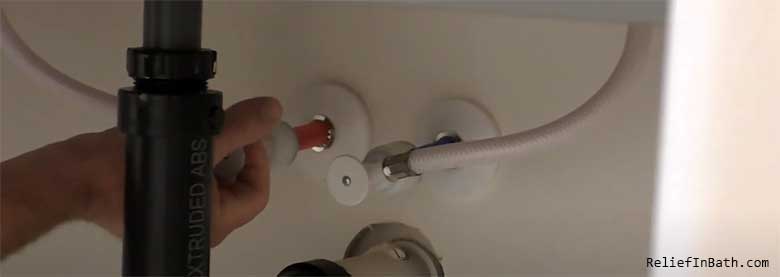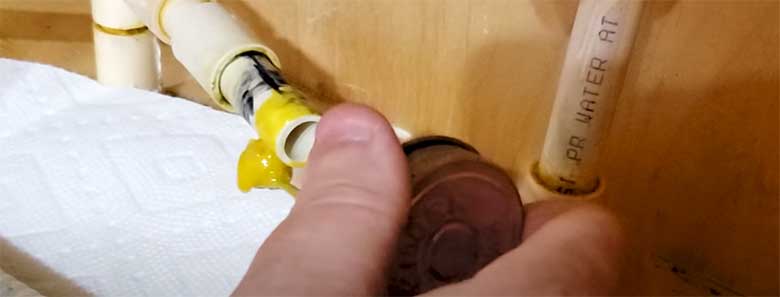It can be incredibly annoying to find your push-pull water valve stuck just when you need it. No matter how much you try, you can’t seem to get it to work.
Don’t worry, it’s possible to fix this problem in a heartbeat if you know exactly what to do.
We’re going to share with you what exactly makes these water valves stuck and help you find a solution. You may not have to call your plumber just yet!
Why Do Push-Pull Water Valves Get Stuck?

It’s fairly common for push-pull water valves to get stuck for multiple reasons. The most obvious reason is the fact that we barely use them.
If you think about it, these things remain unused for a long time. Often, years go by before we feel the need to use them.
There are a few key issues that can cause a smooth-operating push-pull valve to become stiff and immovable over time:
- Mineral Buildup
Hard water deposits slowly accumulate on the internal components of the valve assembly. These mineral deposits restrict the normal low-friction movement of the parts.
- Rust and Corrosion
Exposure to moisture causes the metal internal parts of the valve to rust and corrode. Rust expands and creates friction that prevents normal operation.
- Plastic Deformation
Long-term strain on the plastic handle can cause it to bend or deform slightly. This puts pressure on the valve parts.
- Loose Parts
Vibration and use over time can loosen the fittings holding the valve components together. Loose parts grind or bind.
- Foreign Debris
Small stones, metal chips, Teflon tape, or other construction debris introduced during installation or repairs can interfere with valve operation.
- Chemical Damage
Harsh cleaning agents, mineral deposits, and high water pressure can degrade rubber washers and plastic components over many years, making them stiff and less pliable.
How To Fix A Push-Pull Water Valve That’s Stuck?

Now that we know the probable reasons behind the problem, we can try fixing it. Yes, you may be able to do it yourself if the problem isn’t too severe.
For your convenience, we’ve prepared a simple guide that you can follow to help yourself.
Here is what you can do to unstuck your cemented push-pull water valve.
- Shut Down Your Water Supply
Before you start tweaking your water valve, make sure to turn off your main water supply.
This is to prevent water from leaking out and flooding your place. You don’t want to raise another problem while fixing one, do you?
Also, make sure the pipe is empty and there is no water in it. Open the taps to get rid of all the water from the pipe.
Now, you should try pulling or pushing the faulty valve gently but firmly. See if you can cause any movement and examine how hard it feels.
Again, don’t be too aggressive. If this doesn’t work, move on to the next step.
- Use Wrench and Lubricants
For this step, you’re going to need your pipe wrench and some high-quality lubricants.
Grab your lubricant and pour it onto your valve. Do it carefully so that the substance reaches every nook and cranny of the valve. Afterward, leave the lubricate to do its job of loosening for at least 20 minutes. Remember to clean the lubricate using a towel after you’re doing fix it.
Now, go ahead and pull the valve again. It should be moving again and if it doesn’t, apply some gentle taps on it using a hammer.
If the problem still persists, it’s time to get your wrench. With your wrench, attempt to push and pull the valve gently. You have to be very gentle. Otherwise, you risk breaking your component.
Another thing you can do is heat up the thing using a hairdryer and then apply the lubricant. Afterward, spray the lubricant and let it sit for a couple of minutes.
Then tap again using a hammer carefully. Use your wrench as well. You may want to try this several times. This might loosen your valve and get it unstuck.
- Remove the Handle
If the valve is still immovable, remove the decorative handle exposing the valve’s stem. Spray penetrating oil around the stem and let it soak in. Use locking pliers or a wrench to grip the stem. The added grip and leverage on the bare stem makes it easier to break the valve free.
- Tap with a Hammer
With the handle still removed, try tapping firmly on the sides of the valve body and stem with a hammer. The vibration can help loosen stuck components. Spray more lubricant as needed.
- Remove and Clean Internal Parts
If the above steps don’t work, fully remove the valve. Soak all the internal parts in white vinegar or CLR to dissolve mineral deposits. Scrub away rust and debris. Rinse clean. Lightly sand or file rough spots. Reassemble using fresh plumber’s grease on the seals and stem.
- Replace Rubber Seals and Washers
Examine the rubber washers and seals while disassembled. If they are cracked, brittle, or deformed, replace them with fresh parts. Hard, stiff rubber is often the culprit of stuck valves.
- Replace the Valve
If all attempts fail to fix your plastic push-pull water valve problem, it’s best to replace the valve altogether.
If you’re good at plumbing and feel confident about doing it yourself, feel free to try it. Otherwise, it’s best you call your plumber and let the expert help!
If you want to replace it yourself, watch this video!
How To Prevent Push-Pull Water Valves From Getting Stuck?
You obviously know how irritating it can be to find your valve stuck. After all, that’s why you are out here on the internet, looking for a solution.
Well, you can take some preventive measures to reduce the chance of it ever happening.
As we’ve mentioned before, water valves get stuck mainly due to leaving them unused. Most of us are guilty of using the valves only when the need arises.
If you push and pull the valve regularly even if you don’t need to, the component will remain functional. As a result, it won’t get stuck all that easily.
Lubricating the valve every once in a while can be a good practice as well. This will keep the rust at bay, and your part will remain smooth for a long time.
You should move every valve in your home at least twice a year to prevent this annoying issue. To make the job easier, try setting reminders on your phone or mark the day you want to move your valve on your calendar.
This way, you’re less likely to forget!
Troubleshooting Specific Push-Pull Valve Types
Certain styles of push-pull valves have unique sticking points to be aware of:
1. Gate Valves
Gate valve stems are prone to mineral buildup because of small clearances and their tendency to get slightly misaligned. Ensure the gate is fully raised into the valve body before turning the stem.
2. Ball Valves
Ball valves usually stick due to flattened seals. Replace the seals and lubricate the plastic ball with silicone spray. Avoid overtightening during reassembly.
3. Globe Valves
Stuck globe valves usually have bent stems. Straighten or replace the stem and repack the packing nut with fresh plumber’s tape to reduce friction.
4. Diaphragm Valves
Make sure the diaphragm rubber is pliable and smooth. Hard or improperly seated diaphragms prevent the valve from sealing and operating properly.
5. PVC Valves
Lubricate stuck PVC valves with silicone oil, not petroleum grease which can degrade plastic. Don’t overtighten seals – they just need to be hand tight.
When to Call a Professional
If you’ve tried all the at-home remedies without success, it’s time to call a plumber. A pro has specialized tools and expertise to free extremely stuck valves and repair stem and seal damage.
They can also install a new valve if needed. Leaving a stuck major water valve unfixed is never a good idea!
Frequently Asked Questions (FAQs)
Here are a few frequently asked questions about water valves.
Regular maintenance is a good way to keep your valves functional for a long time. Maintenance shouldn’t only be done when you run into problems. Keep track of the functionality of these components. It’s best to do maintenance at least twice or thrice a year. This will save you a lot of hassle in the long run.
Water valves usually last a long time without malfunctioning. However, they may break for various reasons. When that happens, you should replace the old valve with a new one. You may want to ask your plumber to help with that unless you’re confident about your plumbing abilities.
Technically, it’s not impossible but it’s not recommended. You can keep the water running but you have to be quick to fix the problem. This creates more room for errors.
The price of water valves varies depending on the type of the valve, the quality, and the brand. Plumbers charge differently as well. The cost of replacing a water valve can range from $200 to over $1000.
A can of penetrating oil may be the best option thanks to its low viscosity, allowing the lubricant to reach into the tightest spaces. They are great for freeing rusted parts. Products like WD-40 and JB-80 will come in handy. Fortunately, they are likely to be available at your nearest local hardware store.
Use penetrating lubricant, tap gently with a hammer, leverage with a wrench, remove and clean internal parts, and replace rubber seals and washers as needed. Taking the valve fully apart is key for extreme stuck valves.
Conclusion
Finding your push pull water valve stuck isn’t something you would want to ever happen. Now that you’ve read our article, you know what causes this problem, and how to solve it.
Remember to take preventive measures to prolong the lifespan of your water valve.
Feel free to ask your plumber to help if nothing seems to work because the problem may be too severe.
